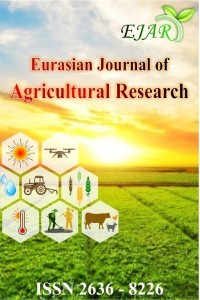Assessment on the Nutrient Status of Lowland Rice Soil Using Minus One Element Technique (MOET)
Assessment on the Nutrient Status of Lowland Rice Soil Using Minus One Element Technique (MOET)
Deficiency symptoms, minus one element technique (MOET), nutrient elements and productive soil,
___
- Castillo, Michelle B. and Mamaril, Cezar, 2018. MINUS-ONE ELEMENT TECHNIQUE (MOET): DIAGNOSTIC TOOL TO ASSESS MULTI-NUTRIENT DEFICIENCIES IN LOWLAND RICE SOILS Philippine Rice Research Institute, Los Banos, Phils.
- Dobermann, A. and T. Fairhurst. 2000. Rice Nutrient Disorders and Nutrient management. International Rice Research Institute (IRRI) p 191.
- Food & Fertilizer Technology Center. Copyright © 1998-2008 FFTC. All rights reserved. Email: info@fftc.agnet.org 5F.14 Wenchow St., Taipei 10616 Taiwan R.O.C. Tel: (886-2) 2362-6239 Fax: (886-2) 2362-0478
- Kirkby, E. A. and Bergmann, W. (Ed.) 1992: Nutritional Disorders of Plants. Journal of plant Nutrition and Soil Science
- Marschner, H. 1986. Mineral Nutrition of Higher Plants 4th ed. Academic Press Inc., San Diego. p 674
- Oteng, J.W. and R. Santanna, 2019. Rice production in Africa: current situation and issues. International Rice Commission Newsletter Vol. 48.
- Rescalsota, J. P., Mamaril, C. P., Peralta, M. T. B., Olvida, I. D. G. and Cruz, R. T. 2005. Philippine Rice Research Inst. Los Baños, College, Laguna, Philippines. Phil Journal of Crop Science.
- Sanchez, P.A., Shepherd, K.D., Soule, M.J., Place, F.M., Mokwunye, A.U., Buresh, R.J., Kwesiga, F.R., Izac, A.N., Ndiritu, C.G. and P.L. Woomer. 1997. Soil fertility replenishment in Africa: An investment in natural resource capital. In: Replenishing soil fertility in Africa. Buresh RJ, Sanchez PA (Eds.). (Spec. Publ. No. 51, Soil Science Society of America, Madison, WI, pp 146.
- http://ricecongress.com/previous/pdflink/4397.pdf retrieved March 14, 2013
- ISSN: 2636-8226
- Yayın Aralığı: Yılda 2 Sayı
- Başlangıç: 2017
- Yayıncı: Muhammed Cüneyt BAĞDATLI
Assessment on the Nutrient Status of Lowland Rice Soil Using Minus One Element Technique (MOET)
Ulysses CAGASAN, Maria Jehan P. LİBRE, Diosdado A. SANTİAGO, Joel A. CANTONEROS, Carmencita M. TUMACA, Aldwin PABLO, George A. HAMORA
Loreme CAGANDE, Ruth O. ESCASİNAS
Rizal John CARUANA, Ulysses CAGASAN
Sustainable Agriculture and New Food Marketing Management System
